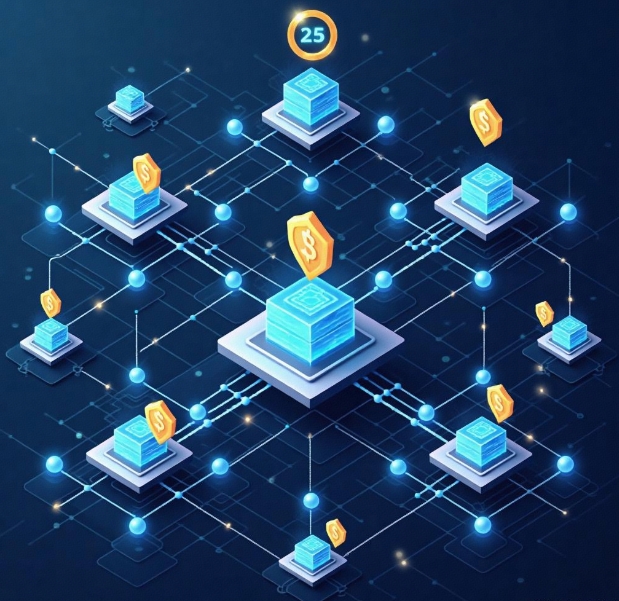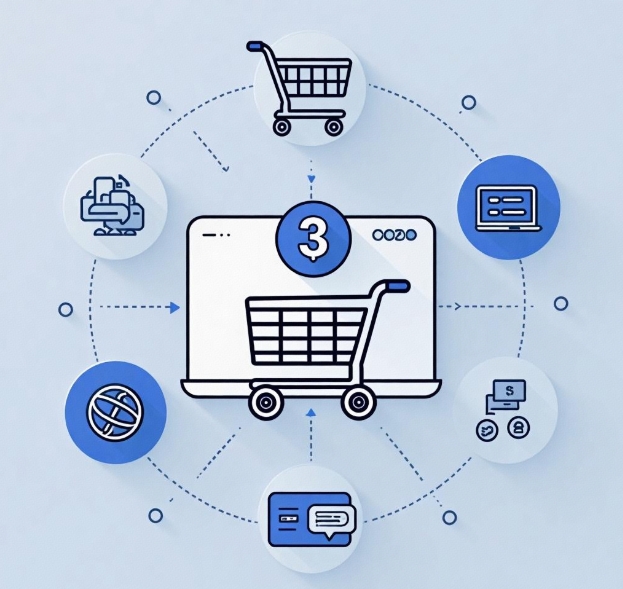Gas Fee Optimization Solutions for Web3 Mall Development
- latest articles
- 1.DApp Development & Customization: Merging Diverse Market Needs with User Experience 2.Analysis of the Core Technical System in DApp Project Development 3.How to achieve cross-chain interoperability in Web3 projects? 4.How does the tokenization of points reconstruct the e-commerce ecosystem? 5.How to Set and Track Data Metrics for a Points Mall? 6.What is DApp Development? Core Concepts and Technical Analysis 7.Inventory of commonly used Web3 development tools and usage tips 8.Development of a Distribution System Integrated with Social E-commerce 9.Six Key Steps for Businesses to Build a Points Mall System 10.What is DApp Development? A Comprehensive Guide from Concept to Implementation
- Popular Articles
- 1.Future Trends and Technology Predictions for APP Development in 2025 2.Analysis of the DeFi Ecosystem: How Developers Can Participate in Decentralized Finance Innovation 3.From Zero to One: How PI Mall Revolutionizes the Traditional E-commerce Model 4.DAPP Development | Best Practices for Professional Customization and Rapid Launch 5.Recommended by the Web3 developer community: the most noteworthy forums and resources 6.How to Develop a Successful Douyin Mini Program: Technical Architecture and Best Practices 7.From Cloud Computing to Computing Power Leasing: Building a Flexible and Scalable Computing Resource Platform 8.Shared Bike System APP: The Convenient Choice in the Era of Smart Travel 9.How to Create a Successful Dating App: From Needs Analysis to User Experience Design 10.From Design to Development: The Complete Process of Bringing an APP Idea to Life
With the continuous development of blockchain technology, Web3 marketplaces, as decentralized e-commerce platforms built on blockchain, have gradually become a hot topic in the digital economy. However, the application of Web3 marketplaces is not just a symbol of technological innovation; their implementation and widespread adoption also face several challenges. Among them, Gas fee optimization is one of the key issues many developers encounter. Gas fees not only affect the user experience but also directly impact the operational costs and competitiveness of the marketplace. Therefore, developers need to employ various technical methods and design approaches to optimize Gas fees, providing users with a smoother and more cost-effective transaction experience.
This article will explore how to optimize Gas fees in Web3 marketplace development from multiple perspectives, introduce several common optimization solutions, and provide detailed analysis with practical examples.
1. Understanding Gas Fees and Their Impact
In the development of Web3 marketplaces, Gas fees are an unavoidable factor. Gas fees refer to the costs required to execute transactions or smart contracts on the blockchain network. These fees are typically borne by users and serve as incentives for miners (or validators) to process and validate transactions.
On smart contract platforms like Ethereum, Gas fees are calculated based on the complexity and execution time of transactions. Complex transactions or contract executions consume more Gas, thereby increasing the fees. Therefore, the level of Gas fees directly affects transaction costs, execution efficiency, and ultimately, the user experience. Especially for applications like Web3 marketplaces, which frequently involve transactions and smart contract interactions, high Gas fees may lead to user attrition and even impact the marketplace's profitability model.
Thus, optimizing Gas fees and reducing transaction costs have become one of the core issues developers must address when building Web3 marketplaces.
2. Gas Fee Optimization Strategies to Improve Transaction Efficiency
2.1 Using Layer 2 Scaling Solutions
Layer 2 refers to second-layer network protocols built on top of the main chain, which alleviate the burden on the main chain by providing more efficient transaction processing methods, thereby effectively reducing Gas fees. In Web3 marketplace development, integrating Layer 2 scaling solutions is one of the key methods to reduce Gas fees.
Currently, mainstream Layer 2 solutions include Optimistic Rollups, ZK-Rollups, and Plasma. These technologies significantly increase transaction throughput and reduce Gas fees to as low as 1/10 of those on the main chain by moving transaction and computation processing off-chain or to the second layer. For Web3 marketplaces, adopting Layer 2 scaling solutions can effectively enhance transaction speed and lower user transaction costs.
For example, Optimistic Rollups reduce Gas fees by batching transactions and delaying finality, making them suitable for high-frequency e-commerce scenarios. ZK-Rollups, on the other hand, achieve efficient batch processing through zero-knowledge proofs, offering the advantage of higher privacy protection and even lower Gas fees.
2.2 Optimizing Smart Contract Design
Smart contracts play a crucial role in Web3 marketplaces, handling user payments, order management, and potentially various complex transaction logics. However, the complexity of smart contracts directly impacts Gas fees. Complex smart contracts require more computational and storage resources, leading to higher Gas fees.
To optimize Gas fees, developers can simplify smart contract design through the following methods:
Avoid redundant operations: Unnecessary operations in contracts consume additional Gas fees. For instance, frequent state updates and complex conditional judgments can increase Gas fees. Therefore, developers need to carefully review contract logic and minimize unnecessary computations.
Use more efficient data structures: Choosing appropriate data structures can reduce the computational load of contracts, thereby lowering Gas fees. For example, using mappings instead of arrays can effectively reduce storage space usage and operational complexity.
Gas fee calculation optimization: Optimize Gas estimation and calculation methods in contracts to avoid unnecessary Gas consumption. For instance, avoiding repeated calculations and reducing loop usage can save Gas fees to some extent.
2.3 Batch Transactions and Transaction Aggregation
For Web3 marketplaces, user transactions are often batched. For example, users may make multiple product purchases or batch payments in a short period. Each transaction requires paying Gas fees, which undoubtedly increases the marketplace's costs.
A common optimization method is to use batch transactions and transaction aggregation. Batch transaction technology can bundle multiple transactions into a single transaction for processing, significantly reducing the Gas fees per transaction. For example, when multiple users purchase products in a marketplace, smart contracts can merge multiple transactions into one, reducing the Gas fees paid individually by multiple users.
Transaction aggregation, on the other hand, combines multiple transactions through aggregation platforms (such as 0x, 1inch, etc.), thereby lowering transaction costs. This has significant optimization potential for multi-user payments and product purchases in Web3 marketplaces.
2.4 Prepaying Gas Fees
Web3 marketplaces can also adopt innovative methods to prepay Gas fees, distributing the costs to merchants or the marketplace platform itself rather than having users bear them directly. For example, marketplaces can offer Gas fee payment services, where merchants prepay Gas fees for users during transactions. This way, users do not need to worry about Gas fees when purchasing products, thereby improving their shopping experience.
For merchants, this model may require compensating for these costs by increasing product prices or adding transaction fees, but it positively impacts user retention and transaction volume for the marketplace.
3. Using Other Blockchain Platforms to Reduce Gas Fees
Although Ethereum is one of the most popular blockchain platforms, its high Gas fees cannot be overlooked. To reduce Gas fees, Web3 marketplace developers can consider migrating their platforms to other blockchain platforms with lower Gas fees. Below are several blockchain platforms suitable for Web3 marketplaces with low Gas fees:
3.1 Binance Smart Chain (BSC)
Binance Smart Chain (BSC) is a blockchain compatible with Ethereum, designed to provide faster transaction speeds and lower Gas fees. BSC's transaction fees are typically much lower than Ethereum's, and its transaction confirmation speed is faster, making it one of the preferred platforms for many decentralized applications (DApps).
For Web3 marketplaces, migrating to the BSC platform can significantly reduce user Gas fees, thereby enhancing the marketplace's user experience. BSC's ecosystem is also continuously expanding, providing more technical and service support for Web3 marketplaces.
3.2 Polygon (MATIC)
Polygon is a sidechain network compatible with Ethereum, designed to address Ethereum's scalability issues and provide a low-Gas-fee transaction experience. Polygon uses smart contracts similar to Ethereum but significantly reduces transaction costs due to its more efficient consensus mechanism and lower network congestion.
Web3 marketplaces can migrate their platforms to Polygon, reducing user transaction costs and improving platform transaction efficiency through Polygon's high throughput. Additionally, Polygon supports various development tools and services, making it easier for developers to migrate and deploy marketplace applications.
3.3 Solana
Solana is a high-throughput, low-latency blockchain platform designed for high-frequency transactions and decentralized applications (DApps). Solana's transaction fees are extremely low, and it can process thousands of transactions per second, making it an ideal choice for many large Web3 marketplaces.
Solana's low Gas fees and high performance provide significant development opportunities for Web3 marketplaces. For e-commerce platforms that need to handle large volumes of transactions, Solana is undoubtedly a blockchain platform worth considering.
4. User Education and Transparency
While technical methods can optimize Gas fees to some extent, the final optimization effect also depends on users' understanding and acceptance of Gas fees. Therefore, developers should strengthen user education in Web3 marketplaces, enhance users' awareness of Gas fees, and help them understand the calculation methods and optimization measures for Gas fees.
For example, developers can provide real-time Gas fee calculation tools on marketplace pages, allowing users to clearly see the Gas fees required for their transactions and make more informed decisions. Additionally, platforms can offer optimization suggestions to help users choose the most suitable transaction timing to reduce Gas fees.
Conclusion
Gas fees are an unavoidable issue in Web3 marketplace development, and their high costs may impact the user experience and market competitiveness of the marketplace. Therefore, developers should adopt a series of optimization measures, including using Layer 2 scaling, optimizing smart contracts, implementing batch transactions, and selecting low-Gas-fee blockchain platforms, to reduce Gas fees and improve transaction efficiency.
Through continuous innovation and improvement, Web3 marketplaces will be able to provide higher-quality, lower-cost services, attracting more users to participate in the decentralized e-commerce ecosystem and driving the development of the digital economy.
-

How does the tokenization of points reconstruct the e-commerce ecosystem?
With the continuous advancement of internet technology and the gradual prolifera···
-

How to Set and Track Data Metrics for a Points Mall?
With the rapid development of the e-commerce industry, points malls, as a common···
-

Development of a Distribution System Integrated with Social E-commerce
With the rapid development of internet technology, the e-commerce industry has e···

 Blockchain
Blockchain












